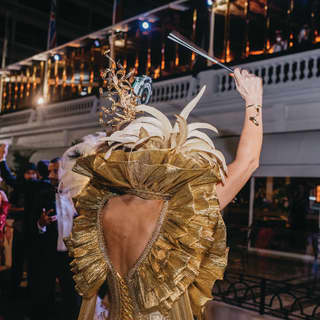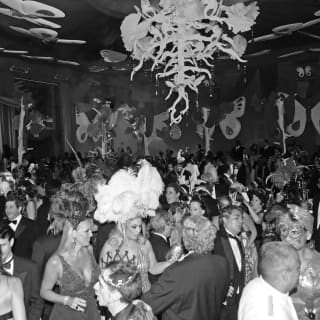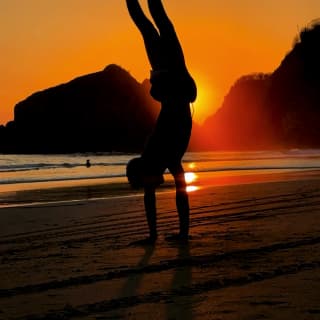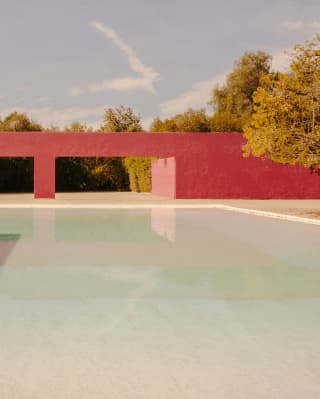Vamos À Festa!
Vamos À Festa!

Rio Carnival is rooted in the fabric of Brazilian tradition. Discover the history of the biggest party in the world, where you need to stand out to fit in.
“As she moves, she's like a samba that swings so cool and sways so gentle.” So goes the fabled bossa nova tune, “The Girl from Ipanema,” a loving ode to Rio de Janeiro’s most infamous beauty. Just like the tune’s namesake, the spirit of samba pulsates throughout the Rio Carnival. It’s a joy-filled festa that attracts two million revellers per day each year to the streets of Brazil’s most sun-kissed and storied city.
Partying is a sacred art in Brazil, and the Rio Carnival is the pinnacle of this time-honored tradition. Thrumming with the intoxicating rhythm of drums, the streets pack out for six days in a celebration of diversity. Yet more lyrics from the famed song – “tall and tan and young and lovely” – spring to mind as you observe the dancers igniting Rio’s streets. Skilled showgirls with bronzed skin and wide grins lead samba bands raucously through the city. Here no outfit is too ostentatious, and golden sequins glint in the heady sunshine.
The thrilling spirit of the samba kicks up a notch in the ‘stadium of samba,’ Sambodromo, designed by Brazil's world-famous architect Oscar Niemeyer. But if you don’t make it into the stadium, you’ll still find plenty of cariocas enjoying the atmosphere in street parties known as blocos. On the mosaicked pavements will be celebrants resplendent in feathers, sequins, and every prismatic material in-between.


FAMED FESTA
This exhilarating atmosphere of community and togetherness dates all the way back to 1723, when the first Rio Carnival took place. Each year, dancers, musicians and carros alegóricos (decorated floats) take to the streets, led by approximately 200 samba schools. These groups are formed by various Brazilian communities, who practice year-round. The top twelve samba schools have the added pressure of competition, with the winning squad being crowned the number one samba school in Rio.
The first of these schools formed in Rio in the 1920s, around the same time that the iconic Copacabana Palace, A Belmond Hotel swung open its doors. Samba first began to emerge in Western consciousness in the 1940s, thanks in part to Carmen Miranda’s iconic roles in films such as That Night in Rio and The Gang's All Here. However, the infectiously rhythmic dance has roots that developed far earlier. Differing from ballroom samba, Brazilian samba was created by former West African slaves that were brought to Brazil during Portuguese colonisation.
Influenced by Angolan and Luso-Hispanic music genres, it pulsates with an infectious rhythm and reflects the carnival’s spirit of conviviality. What’s more, it symbolizes samba schools’ united pride under a common regional background. The dance’s ethos of spiritual emancipation, set to the liberating backing of the bateria (a drum orchestra), is the perfect dance to accompany the joyous parades. United and moving, under the blazing Brazilian sunshine.

THE MOST GLAMOUROUS CARNIVAL IN THE WORLD
Copacabana Palace has long been considered the Golden Ticket of all carnival festivities. An evening that promises decadence, joy and glorious excess, the Copa Ball, or 'Baile do Copa', has always attracted celebrities and bon vivants world-over; previous starry guests have included Veruschka, Orson Welles, Christian Louboutin, Brigitte Bardot and many more. With exciting themes, opulent queens, pioneering entertainment and resolute glamor, there’s no destination more fitting for the world’s biggest party.
When is the Rio Carnival this year? Mark your calendars: festivities take place from Friday 28 February until Saturday 8 March 2025. For this year, we have partnered with nonprofit organisation Parley for the Oceans, with this year's ball theme being 'Infinite Ocean Blue'. Guests can visit an immersive Parley space, experiencing a multimedia installation designed to raise awareness of the vital importance of ocean conservation. All décor and proceeds will be donated to “Entre o Céu e a Favela,” a local organisation dedicated to promoting social inclusion, economic development and environmental responsibility in Rio's favelas.
But if you can’t swing a hot ticket to the Copa Ball, you can still celebrate the carnival spirit at the hotel. Legend has it that the word ‘carnival’ stems from the Latin expression carne vale. Literally meaning ‘farewell to the meat’, revellers celebrated a final party before their fast for Lent. Why not be true to tradition, and feast at Copacabana Palace’s Michelin-starred eatery Ristorante Hotel Cipriani? You’ll find a joyful blend of Italian and Brazilian cuisine here, with our celebrated chefs poised to lead you an epicurean adventure. It’s the bona fide way to ease your appetite before the samba spirit takes over.
Rio Carnival, As Seen by Sam Youkilis
Exploring everyday life with both wit and reverence, Sam Youkilis’ bite-sized social videos effortlessly blend grit and glamour. Discover how he captures the ineffable spirit of the world’s biggest party: Rio Carnival.

Delve deeper into
You might also enjoy

Ask The Concierge: Caterina Cucuzza’s Taormina
Our Ask the Concierge series returns – and this time, we’re heading to Villa Sant’Andrea in Taormina, Sicily. Today, we meet the hotel’s Head Concierge Caterina Cucuzza. She tells us where to find authentic artisanal ceramics, reveals Sicily’s best spots for a shaded gelato and guides us on where to book a romantic dinner for two.

JR on the Making of L’Observatoire
The renowned French artist JR challenges traditions and sparks dialogue with his monumental artistic creations. Turning his eye to the iconic Venice Simplon-Orient-Express where he's designed an entire carriage onboard, the L’Observatoire suite is an artwork in motion. Transforming every detail into an opportunity for introspection and adventure, read JR in his own words as he explores the deeper meaning behind his most ambitious project yet.

Ask The Concierge: Toru Machida's London
Introducing our new series Ask The Concierge, we spoke to Toru Machida, Head Concierge at The Cadogan. With him, we dive in to find out more about the best spots in Chelsea and beyond.

Investigate London’s New Murder Mystery Experience
One train, five courses, ten suspects. A new immersive murder mystery experience on board the British Pullman train is setting off from London for a wildly entertaining whodunit.

Feast on Art at Le Manoir aux Quat’Saisons
For the past forty years, Chef Raymond Blanc OBE has been serving dishes plated like paintings at Le Manoir aux Quat’Saisons – alongside amassing a collection of artistic commissions for the hotel. Inspired by the stories that make this hotel feel like a home, discover some of Le Manoir’s most prized artistic pieces.

An Art & Design Lover’s Guide to Mexico City
While Modernist icons like Frida Kahlo, Diego Rivera and Luis Barragán sowed the seeds of greatness, a new cohort of creatives are steering Mexico City’s cultural conversation into a contemporary space. Beyond the few days in February that make up art week and the well–trodden landmarks that feature in every other city guide, there is plenty more here that promises to reward the art and design lover that is willing to dig deeper.

Rio Carnival, As Seen By Sam Youkilis
Exploring everyday life with both wit and reverence, Sam Youkilis’ bite-sized social videos effortlessly blend grit and glamour. We discover how he captures the ineffable spirit of the world’s biggest party: Rio Carnival.